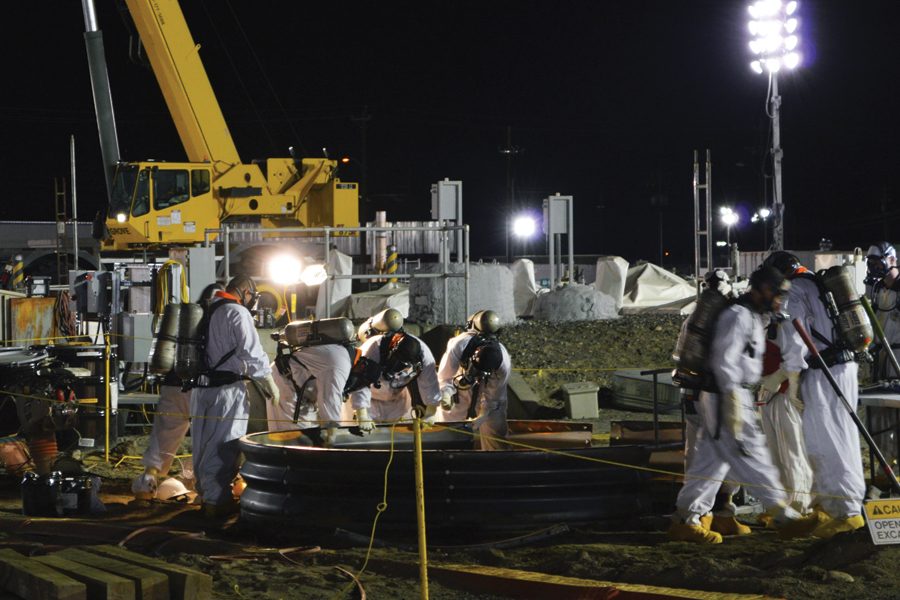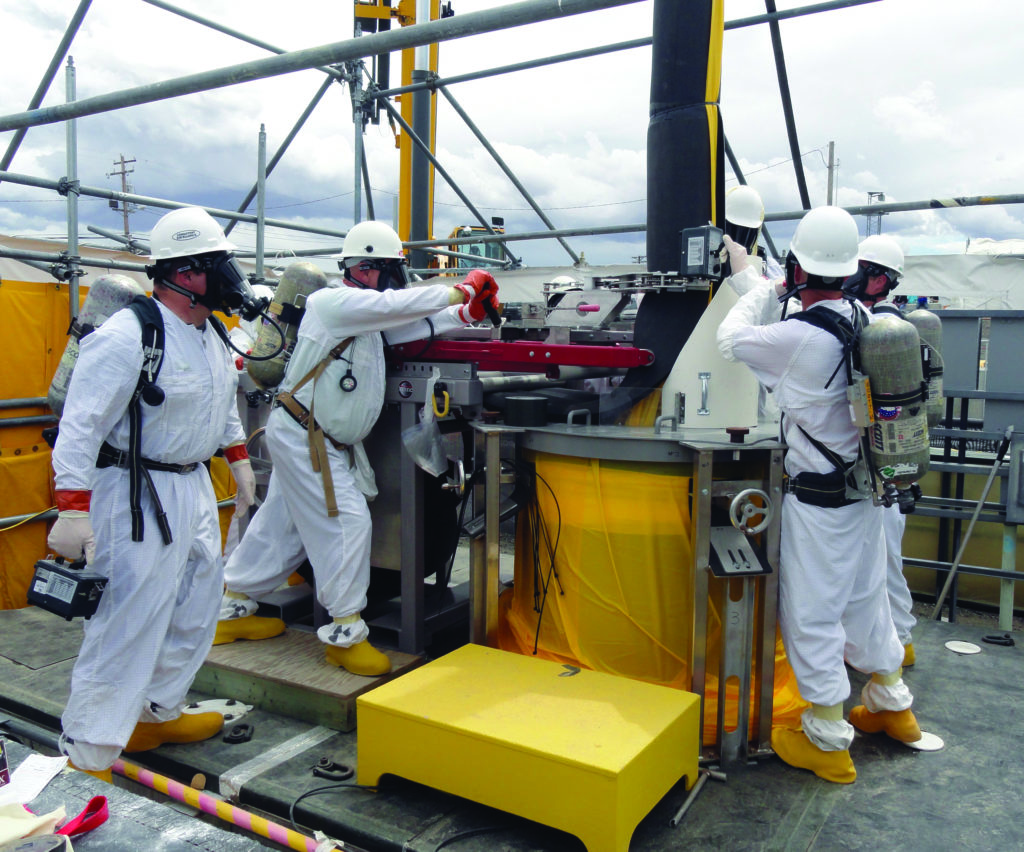
Home » Emptying toxic waste from tanks at Hanford a taxing task
Emptying toxic waste from tanks at Hanford a taxing task

May 16, 2019
In a way, when it comes to tank waste at the Hanford site, the easy stuff has been done. Toxic liquid waste can be transferred until it’s disposed of with a pump.
But what about solid waste?
What about a million-gallon tank with solidified toxic waste sitting inside?
What about 177 of those tanks and 56 million gallons of waste?
The toxic waste stored out of sight in the tank farms on the Hanford site serve as a reminder of progress made, but also how many decades must pass before cleanup is complete.
https://flic.kr/p/WgRdDN
Just ask officials at Washington River Protection Solutions, a subsidiary of AECOM Corp., the contractor tasked with management of and waste retrieval from the 177 tanks.
The company has been on the job for more than a decade, with 18 tanks emptied and one currently under way.
As a mandate of the Tri-Party Agreement, workers must remove 99 percent of the material from each tank.
“We’re coming to the end of our contract here, and it’s exciting to see what we’ve accomplished, and it will be interesting to see what’s going to be accomplished in the years to come,” said Peter Bengtson, communications manager at WRPS.
WRPS is an LLC, which will dissolve when the contract ends at the end of September, but AECOM has bid on the tank farms contract once again.
Most of the tanks contain a waste byproduct from a part of the plutonium production process that occurred when workers needed to dissolve the fuel rods to retrieve plutonium. The chemicals used to dissolve the fuel rods would become radioactive and very hot during this process and could not be re-used.
Scientists at the time opted to build 55,000-gallon to 1 million-gallon underground carbon steel shell storage tanks to store the waste chemicals after this process. Even using carbon steel, it is estimated that 67 of the 177 underground tanks have leaked. The tanks are grouped into 18 farms, and the majority of them are single-shell tanks.

(Courtesy Washington River Protection Solutions)
The site also contains 28 double-shell tanks, which are the preferred storage method for the waste. The tanks originally held both liquid and solid chemical waste, but from 1998 to 2004 more than 2 million gallons of liquid waste was transferred from the single-shell tanks to the double-shell tanks, leaving behind the daunting task of emptying the tanks of solid chemical waste with consistencies ranging from peanut butter to salt cakes. The tanks are only accessible remotely and through pipes with small diameters, creating engineering challenges.
WRPS uses up to 10 waste retrieval methods to clean out solid to sludge-like waste from the tanks.
Methods typically use water in different ways, from sluicing to high pressure, to dissolve the cakes or sludge into a pumpable liquid. This is not always easy, however, and engineers have developed crawler-tractor devices to push or break up solid waste in tanks for it to be dissolved and vacuumed or pumped out. All this work is done remotely because the tanks are roughly 30 feet underground, with the domes and top points of most tanks resting seven to 10 feet underground.
WRPS does more than just retrieve waste; it also monitors all 177 tanks for leaks, chemical consistency and content. Typically, the group works on retrieving waste from one tank at a time, with another work group assessing and preparing the next tank for work.
An added challenge for WRPS is that no two tanks are the same.
“Each one of those waste types may require a different type of removal or retrieval from the tanks, which is where our engineering comes in and works together with the tank operators to develop different approaches and tools that match the profile of the tanks,” said Rob Roxburgh, deputy manager of communications and public relations at WRPS.
He said crews will determine the overall health of the tank and then develop a specific approach for how to best retrieve waste from within. The immediate goal is to transfer waste from the single-shell tanks to the double-shell tanks, but eventually the waste is supposed to be transferred to a waste treatment plant that will sort the waste into high-activity and low-activity waste. The low-activity waste, which will make up the majority of the tank waste, will be vitrified, meaning it will undergo chemical processes to be turned into glass logs and then shipped away for safe storage.
The vit plant, which is being built near the tanks for easy flow from tank storage to treatment, should be operational to treat tank waste by 2023. In the meantime, 159 tanks still need to be emptied. Besides the painstakingly slow pace, WRPS constantly fights aging infrastructure as it works to remove waste, too.
“One of the challenges we deal with out here is the aging infrastructure and managing that in cooperation with managing the tank waste,” Bengtson said. “So the double-shell tanks are supposed to remain intact and hold that waste until it can be treated at the vit plant.”
The single-shell tanks are not compliant to regulatory standards, Bengtson said, which poses an obvious threat for more leaks, especially when 149 of the 177 tanks are single-shell tanks. Even the double-shelled tanks are not always reliable, however, Bengston noted that one of them had leaked into its outer wall.
With new technologies, WRPS is beginning retrieval work on a new farm and the 19th tank currently. WRPS spokespeople believe the process will go quicker on the next farm.
“For this next round of retrievals, which is going to be a collection of 10 tanks, in A and AX farms, we are taking a more holistic approach this time where we are putting hopefully all of the systems in place so that we can go in and move at a faster, more efficient rate,” Roxburgh said. “… We’ve done all of the research for that collection of tanks, and we’re taking a far, wide holistic approach.”
WRPS will only exist, in name, through the completion of its contract come the end of September, at which point the Department of Energy could select a new contractor or AECOM may continue the work on the tanks.
https://www.tricitiesbusinessnews.com/2019/05/hanford-waste-withdrawl/
Local News Hanford
KEYWORDS may 2019




